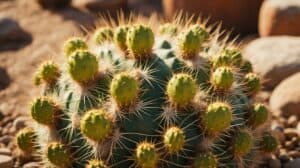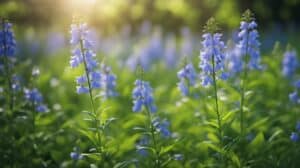Alpinia zerumbet, commonly known as shell ginger, is a tropical plant that is native to eastern Asia.
This plant is a popular choice for gardeners due to its striking appearance and ease of care.
With its lush green foliage and delicate white flowers, the shell ginger is a beautiful addition to any garden or indoor space.

One of the secrets to growing shell ginger is to provide it with the right growing conditions.
This plant thrives in warm, humid environments and requires well-draining soil.
It is important to keep the soil moist but not waterlogged, as too much water can lead to root rot.
Additionally, shell ginger prefers partial shade and should be protected from direct sunlight, especially during the hottest parts of the day.
In this article, we will explore the various factors that contribute to the successful growth of shell ginger.
From soil type to watering frequency, we will cover everything you need to know to keep your shell ginger healthy and thriving.
Whether you are a seasoned gardener or a beginner, this guide will provide you with the knowledge and tools necessary to cultivate a beautiful and flourishing shell ginger plant.
Understanding Alpinia Zerumbet
Species Overview
Alpinia Zerumbet, also known as Shell Ginger, is a tropical plant that belongs to the Zingiberaceae family.
It is native to East Asia, particularly Japan and China, but can also be found in other parts of the world like Brazil and Hawaii.
The plant can grow up to 8 feet tall and produces large, green leaves that have a glossy texture.
The flowers are cone-shaped and have a white or pink color.
Shell Ginger is a popular ornamental plant because of its attractive foliage and flowers. It is also used for medicinal purposes in traditional medicine.
The plant contains compounds that have anti-inflammatory and antioxidant properties, which make it useful in treating various ailments.
Historical Significance
Shell Ginger has a long history of use in traditional medicine.
In Japan, it is known as “getto” and is used to treat various ailments like coughs, colds, and fever.
The plant is also used in traditional Chinese medicine to treat digestive problems, arthritis, and respiratory infections.
In addition to its medicinal uses, Shell Ginger has cultural significance in many countries.
In Japan, the plant is used in festivals and ceremonies, and the flowers are used in tea ceremonies.
In Hawaii, the plant is used in leis and other decorations.
Overall, Alpinia Zerumbet is a fascinating plant with a rich history and many uses.
Whether you are interested in its ornamental value or its medicinal properties, it is a plant worth learning more about.
Cultivation Tips

Choosing the Right Location
Alpinia Zerumbet, also known as the Shell Ginger, is a tropical plant that thrives in warm climates.
When choosing a location to grow your Shell Ginger, it is important to keep in mind that it requires partial shade to full shade.
Direct sunlight can cause the leaves to burn and turn yellow.
Soil Requirements
The Shell Ginger prefers well-draining soil that is rich in organic matter. A soil pH of 6.0 to 7.0 is ideal for this plant.
If the soil is too acidic, adding lime can help raise the pH level.
On the other hand, if the soil is too alkaline, adding sulfur can help lower the pH level.
Watering Needs
The Shell Ginger requires regular watering, especially during the hot summer months. It is important to keep the soil moist but not waterlogged.
Overwatering can lead to root rot, which can be fatal to the plant.
During the winter months, the plant can be watered less frequently as it goes into a dormant state.
To ensure the best growth and health of your Alpinia Zerumbet, it is recommended to fertilize it every 2-3 months with a balanced fertilizer.
Additionally, removing any dead or damaged leaves can help promote new growth.
With these cultivation tips, you can successfully grow and enjoy the beauty of the Shell Ginger in your own garden.
Maintenance and Care

Pruning Techniques
Alpinia Zerumbet, commonly known as Shell Ginger, requires regular pruning to maintain its shape and promote healthy growth.
Pruning should be done after the blooming season, which typically occurs in late summer or early fall.
The following are some pruning techniques that can be used:
-
Remove dead or damaged leaves: Dead or damaged leaves should be removed from the plant to prevent the spread of disease and to improve the plant’s appearance.
-
Cut back old stems: Old stems that have finished blooming should be cut back to the ground to encourage new growth.
-
Trim back overgrown branches: Overgrown branches can be trimmed back to a healthy bud or node to promote new growth and maintain the plant’s shape.
Pest and Disease Management
Alpinia Zerumbet is generally a hardy plant, but it can be susceptible to a few pests and diseases. Here are some tips to manage common issues:
-
Spider mites: Spider mites are a common pest that can infest Shell Ginger.
They can be controlled by spraying the plant with a solution of water and mild soap.
-
Scale insects: Scale insects can also be a problem for Shell Ginger. They can be treated by using a horticultural oil spray.
-
Leaf spot: Leaf spot is a fungal disease that can affect Shell Ginger.
It can be prevented by avoiding overhead watering and ensuring good air circulation around the plant.
Regular maintenance and care are essential for the health and growth of Alpinia Zerumbet.
By following these pruning techniques and pest and disease management tips, gardeners can enjoy a beautiful and healthy Shell Ginger plant.
Propagation Methods

Division
Alpinia Zerumbet, commonly known as Shell Ginger, can be propagated through division.
This method is best done during the spring or fall when the plant is actively growing.
To propagate through division, carefully dig up the plant and separate the rhizomes with a sharp knife or garden shears.
Be sure each division has a good amount of roots and foliage. Plant each division in a well-draining soil mixture and keep it moist until it establishes.
Seed Germination
Propagation through seed germination is also possible with Alpinia Zerumbet. However, it is a slow and unpredictable process.
To propagate through seed germination, collect the seeds from the mature fruit and soak them in water for a few hours.
Sow the seeds in a well-draining soil mixture and keep it moist until the seedlings emerge.
It can take up to six months for the seeds to germinate, so patience is key.
It’s important to note that the resulting plants from seed germination may not be true to the parent plant and may exhibit different characteristics.
Therefore, division is the preferred method of propagation for maintaining the desired traits of the parent plant.
Frequently Asked Questions

How can I successfully grow Alpinia zerumbet indoors?
Alpinia zerumbet can be grown indoors with proper care. It requires bright, indirect sunlight and a well-draining soil mix.
Keep the soil moist, but not waterlogged, and avoid letting the plant sit in standing water.
Indoor temperatures should be kept between 60-80°F (15-27°C), and humidity levels should be around 50-60%.
What are the ideal conditions for potting and repotting variegated shell ginger?
Variegated shell ginger should be potted in a well-draining soil mix with good aeration.
It prefers partial to full shade and requires regular watering to keep the soil moist.
Repotting should be done every 2-3 years, preferably in the spring, using a slightly larger pot.
What type of fertilizer should be used for shell ginger plants, and how often?
A balanced, slow-release fertilizer with an NPK ratio of 10-10-10 or 20-20-20 is ideal for shell ginger plants.
Fertilize every 2-3 months during the growing season (spring and summer), and reduce fertilization during the winter months.
Can shell ginger plants be propagated, and if so, what is the best method?
Yes, shell ginger plants can be propagated through division or stem cuttings.
Division should be done during the spring when repotting, and stem cuttings should be taken from mature, healthy plants in the spring or summer.
Dip the cuttings in rooting hormone and plant in a well-draining soil mix.
What are the pruning requirements for a healthy shell ginger plant?
Pruning is not necessary for shell ginger plants, but removing dead or damaged leaves and flowers can improve the plant’s appearance.
Cut back the entire plant to the ground in the fall after the first frost to prepare for winter dormancy.
Is Alpinia zerumbet edible, and are there any culinary uses for it?
Alpinia zerumbet is edible, and its leaves and rhizomes are used in traditional medicine and cuisine in some cultures.
However, it is important to note that some varieties may be toxic or cause allergic reactions in certain individuals.
Consult with a medical professional before consuming or using Alpinia zerumbet for any purpose.














